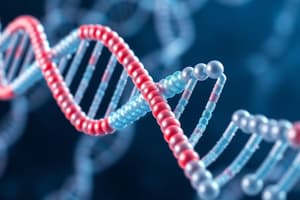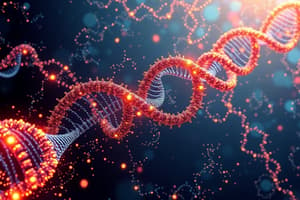Podcast
Questions and Answers
What is the purpose of restriction enzymes in molecular biology?
What is the purpose of restriction enzymes in molecular biology?
Restriction enzymes cut DNA at specific locations, allowing researchers to create DNA fragments for analysis and cloning.
Explain how gel electrophoresis separates DNA fragments.
Explain how gel electrophoresis separates DNA fragments.
Gel electrophoresis separates DNA fragments based on size and charge as they migrate through an agarose gel in an electrical field.
What is recombinant DNA technology, and why is it significant?
What is recombinant DNA technology, and why is it significant?
Recombinant DNA technology involves combining DNA from different species to create new genetic combinations valuable for science and medicine.
List the key components required for PCR.
List the key components required for PCR.
How can gene therapy be used in medicine?
How can gene therapy be used in medicine?
Describe the role of primers in the PCR process.
Describe the role of primers in the PCR process.
What advantages does recombinant DNA technology provide to agriculture?
What advantages does recombinant DNA technology provide to agriculture?
What is the significance of creating genome libraries in genetic research?
What is the significance of creating genome libraries in genetic research?
What is the primary function of restriction enzymes in genetic engineering?
What is the primary function of restriction enzymes in genetic engineering?
Define the term 'palindrome' in the context of DNA sequences.
Define the term 'palindrome' in the context of DNA sequences.
Explain how bacteria protect their own DNA from being cut by restriction enzymes.
Explain how bacteria protect their own DNA from being cut by restriction enzymes.
What role does gel electrophoresis play in restriction mapping?
What role does gel electrophoresis play in restriction mapping?
What is a restriction map and why is it important?
What is a restriction map and why is it important?
Describe the nomenclature used for naming restriction enzymes.
Describe the nomenclature used for naming restriction enzymes.
List two methods of DNA cloning mentioned in the context.
List two methods of DNA cloning mentioned in the context.
What are restriction endonucleases, and how do they differ from other enzymes?
What are restriction endonucleases, and how do they differ from other enzymes?
Flashcards
Restriction Enzyme Digestion
Restriction Enzyme Digestion
A technique used to cut DNA at specific sequences using enzymes.
Restriction Enzyme
Restriction Enzyme
A type of enzyme found in bacteria that cuts DNA at specific sequences.
Restriction Mapping
Restriction Mapping
Producing DNA fragments of varying lengths by using restriction enzymes and visualizing them based on size.
Palindrome
Palindrome
Signup and view all the flashcards
Gel Electrophoresis
Gel Electrophoresis
Signup and view all the flashcards
Restriction Mapping
Restriction Mapping
Signup and view all the flashcards
Recombinant DNA Technology
Recombinant DNA Technology
Signup and view all the flashcards
Recombinant DNA Technology
Recombinant DNA Technology
Signup and view all the flashcards
Recombinant DNA
Recombinant DNA
Signup and view all the flashcards
Polymerase Chain Reaction (PCR)
Polymerase Chain Reaction (PCR)
Signup and view all the flashcards
Gene Therapy
Gene Therapy
Signup and view all the flashcards
Recombinant DNA
Recombinant DNA
Signup and view all the flashcards
Genome Library
Genome Library
Signup and view all the flashcards
Restriction Enzyme Use
Restriction Enzyme Use
Signup and view all the flashcards
Gel Electrophoresis
Gel Electrophoresis
Signup and view all the flashcards
Genetic Engineering
Genetic Engineering
Signup and view all the flashcards
Study Notes
Genetic Engineering: Introduction & Restriction Enzymes
- Genetic engineering is the manipulation and combination of DNA molecules from different sources.
- Objectives include defining restriction enzymes (REs), palindromes, restriction mapping, and outlining how REs work.
- Recombinant DNA technology uses molecular scissors (restriction enzymes) to cut DNA at specific sequences.
- Gel electrophoresis separates macromolecules (DNA, RNA, proteins) by size and charge.
- DNA cloning uses plasmid and PCR methods.
Restriction Enzymes
- Restriction enzymes are DNA cutting enzymes found in bacteria as a defense mechanism against foreign DNA.
- They are also called Restriction Endonucleases.
- A restriction enzyme recognizes and cuts DNA only at a specific nucleotide sequence.
- Bacteria protect their own DNA by modifying their nucleotides via DNA methylation.
- Restriction enzymes cleave DNA at specific short nucleotide sequences.
- Enzymes can create sticky ends (staggered cuts) or blunt ends (cleave on the same spot on both strands).
Palindromes
- Recognition sequences in restriction enzymes are often palindromic.
- This means the sequence reads the same on one strand in the reverse direction on the complementary strand.
- Palindromic sequences vary in length from 4 to 8 nucleotides.
How Restriction Enzymes Work
- Blunt ends: Enzyme cleaves opposing phosphodiester bonds, creating no unpaired bases on the ends.
- Sticky ends: Staggered cuts create unpaired nucleotides at the ends. These ends can pair with complementary sticky ends.
Types of Restriction Enzymes
- Type I: Cleaves DNA at random sites further than 1000 base pairs from the recognition sequence, requiring ATP.
- Type II: Isolated in 1970, cleaves DNA within the recognition sequence, requiring no ATP.
- Type III: Cleaves about 25 base pairs from the recognition sequence, requiring ATP.
Nomenclature
- Enzyme names follow a pattern:
- The first letter of the genus name is capitalized.
- The first two letters of the species name follow, in italics.
- The strain or identification type is displayed as a subscript.
- (e.g., EcoRI from Escherichia coli strain RY13).
Restriction Mapping
- Restriction mapping is the process of identifying the locations of restriction endonuclease cleavage (cut) sites within a DNA fragment.
- It involves digesting DNA with a series of restriction enzymes and separating the resulting DNA fragments by gel electrophoresis.
- Fragment sizes are used to determine the distance between enzyme sites.
Uses of Restriction Enzymes
- Creating genome libraries
- Cloning DNA molecules
- Studying nucleotide sequences.
Recombinant DNA Technology
- Recombinant DNA technology joins DNA molecules from two different species and inserts them into a host organism to produce new combinations that are valuable to science, medicine, and agriculture.
Gel Electrophoresis
- Gel electrophoresis is a technique used to separate macromolecules (DNA, RNA, proteins) based on size and charge.
- Fragments migrate through the gel according to their size. Smaller fragments travel further.
DNA Cloning
- DNA cloning generates billions of identical molecules from a single DNA molecule, using restriction enzymes and electrophoresis.
Polymerase Chain Reaction (PCR)
- PCR is a technique that copies a specific region of a template DNA sequence.
- It uses DNA polymerase to synthesize new complementary strands of DNA.
Requirements & Process of PCR
- DNA template, DNA polymerase, primers, nucleotides.
- Strand separation (denaturation), primer binding (annealing), new DNA synthesis (extension)
- Exponential amplification of the sequence target
Genetic Engineering: Application
- Medicine: Production of pharmaceuticals, gene therapy
- Agriculture: Plants and animal husbandry
Uses of Recombinant DNA Technology
- Medicine: Creation of pharmaceutical products (like human insulin), gene therapy
- Agriculture: Improving plant traits (yield, nutrition), animal husbandry.
Creating Pharmaceutical Products
- Bacteria can be genetically engineered to produce pharmaceuticals like insulin.
Other Pharmaceutical Products
- The technique is applied for producing various pharmaceuticals, including tumor necrosis factor, interleukin-2, prourokinase, and taxol for treatment.
Gene Therapy
- Gene therapy is an experimental technique that uses genes to treat or prevent diseases.
- The technique can replace mutated genes, knock out mutated genes that function improperly, or introduce new genes.
Plant Genetic Engineering
- Genetically engineered plants can show resistance to herbicides, insects, viruses.
- These plants may have altered oil content, delayed fruit ripening, or pollen control.
Animal Husbandry
- Transgenic animals are created using advancements in DNA technology. Fertilize eggs in the lab, isolate and clone desired genes , and inject genes to be incorporated.
Ethical Considerations: Pros
- Crops can taste better, have less ripening time, higher nutrition, or improved resistances. Animals offer enhanced resistance, productivity, or health. Environmentally friendly herbicides, waste reduction, and improved processing are possible with GE. Society may gain from more food supply.
Ethical Considerations: Cons
- Safety concerns, access to technology, ethical implications of genetic modification (tampering with nature), and labeling issues are concerns.
Top Genetically Modified Foods
- Top genetically modified foods include corn, soybeans, cotton, papa, rice, rapeseed, potatoes, tomatoes, dairy products, and peas.
What Are the Ethical Implications of Creating "Designer Babies"?
- Concerns exist about the ethical implications of choosing specific traits in children.
Studying That Suits You
Use AI to generate personalized quizzes and flashcards to suit your learning preferences.




